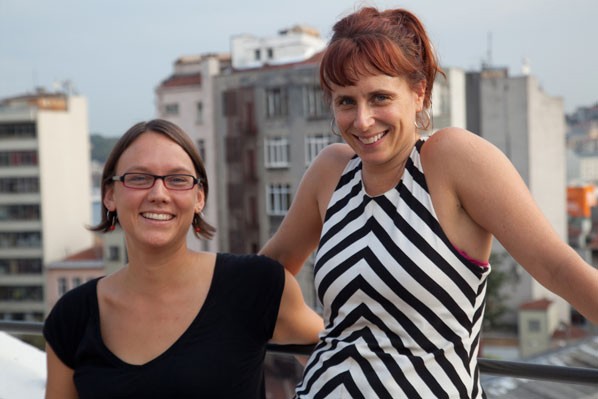GVSU alumna Julie Upmeyer makes art out of ordinary

GVL / Courtesy – Jonathan Lewis Julie Upmeyer
Feb 15, 2016
The phrase “one man’s trash is another man’s treasure” may be cliché, but for one Grand Valley State University art alumna, it’s become a guiding philosophy as she turns objects others deem worthless into priceless pieces of art.
One such piece by 2003 GVSU graduate Julie Upmeyer is her “Gyration” series. Made from repurposed bicycle tires and hubcaps, the spinning wheels of “Gyration” have become iconic parts of GVSU’s Kirkhof Center. Along with two other permanently installed pieces at GVSU, “Gyration” reflects Upmeyer’s view of art that she said originated during her childhood.
Upmeyer said her artistic ambition was inspired by her mother’s nonprofit organization, Arts & Scraps, which uses repurposed materials to help children learn creativity.
“My mom gave me a basement full of recycled industrial scraps even before I had my first proper set of crayons,” Upmeyer said.
While at GVSU, Upmeyer balanced her time creating art with her position on the swim team. Henry Matthews, director of galleries and collection, said that he remembered how this reflected Upmeyer’s ability to make light of life’s mundane moments.
“Because (Upmeyer) was a swimmer, her hair was often a mess from the chlorine that she had to be in all the time. The way she dealt with that, which I really loved, is every week or so she would have different colored hair. It might be orange, it might blue, red, yellow and really loud, garish colors,” Matthews said. “She had to accept the fact that if you’re a swimmer you have to be in the water, so she just took it as an artist and had fun with it. She made it a part of who she was.”
After graduating from GVSU with a bachelor’s of fine arts in ceramics, sculpture and graphic design, Upmeyer began to travel the world as an artist. She has worked in India, Germany, Austria, the Netherlands and Greece. She currently resides and works in Istanbul, where she has already held several gallery shows.
Upmeyer said that being an artist abroad presents a new experience.
“In the states, there’s a value placed on competence. It’s cool if you have a band saw and can cut your own wood…it’s cool if you do it yourself,” Upmeyer said. “But in Turkey, it’s a friends and family culture, so it doesn’t matter if you can do that or not. If you know someone who has the saw, then it’s the whole social engagement of the person who will cut the piece of wood for you and that cementing and growing of personal relationships is how things get done. It’s a whole different value system. “
Upmeyer’s most recent work in Istanbul is an installation piece called “The Metromorphic Varieties.” Depicting animals in urban camouflage, Upmeyer said this piece was inspired by her experience in complex living environments like urban Istanbul.
“(The Metromorphic Varieties) was very much inspired by many years living in a very urban, very layered, very dense environment,” Upmeyer said. “This project is kind of a utopian, dystopian, futuristic idea I had that birds, rabbits, cats and dogs and entire species that are born, are living and die in urban environments. It’s really playful in one way and then in another way, (it’s a) disturbingly beautiful view of the future of urban living.”
Upmeyer said that, from the beginning, the idea of environment and space affected her creative process.
“I always had a lot of materials around me and it wasn’t clear what you were supposed to do with them,” she said. “The challenge for me was always, ‘OK so there’s this circle, there’s this block. What could that be? How could you transform that from one thing to another thing?’ My practice continues along this thread of being inspired by the materials, processes and things around me.”
Paul Wittenbraker, 2-D foundations and visual studies professor, said practices are something Upmeyer excels in.
“(Upmeyer’s) really keen on practices: things that you would do over and over again that might be mundane,” Wittenbraker said. “(For her), it becomes a meditative thing but also a commentary on just how boring it is to be human. It’s just the same thing day after day, so a lot of her work is related to that basic experience of repetition and redundancy. And out of that, she likes to create these things that celebrate the wonder of being alive.”






















